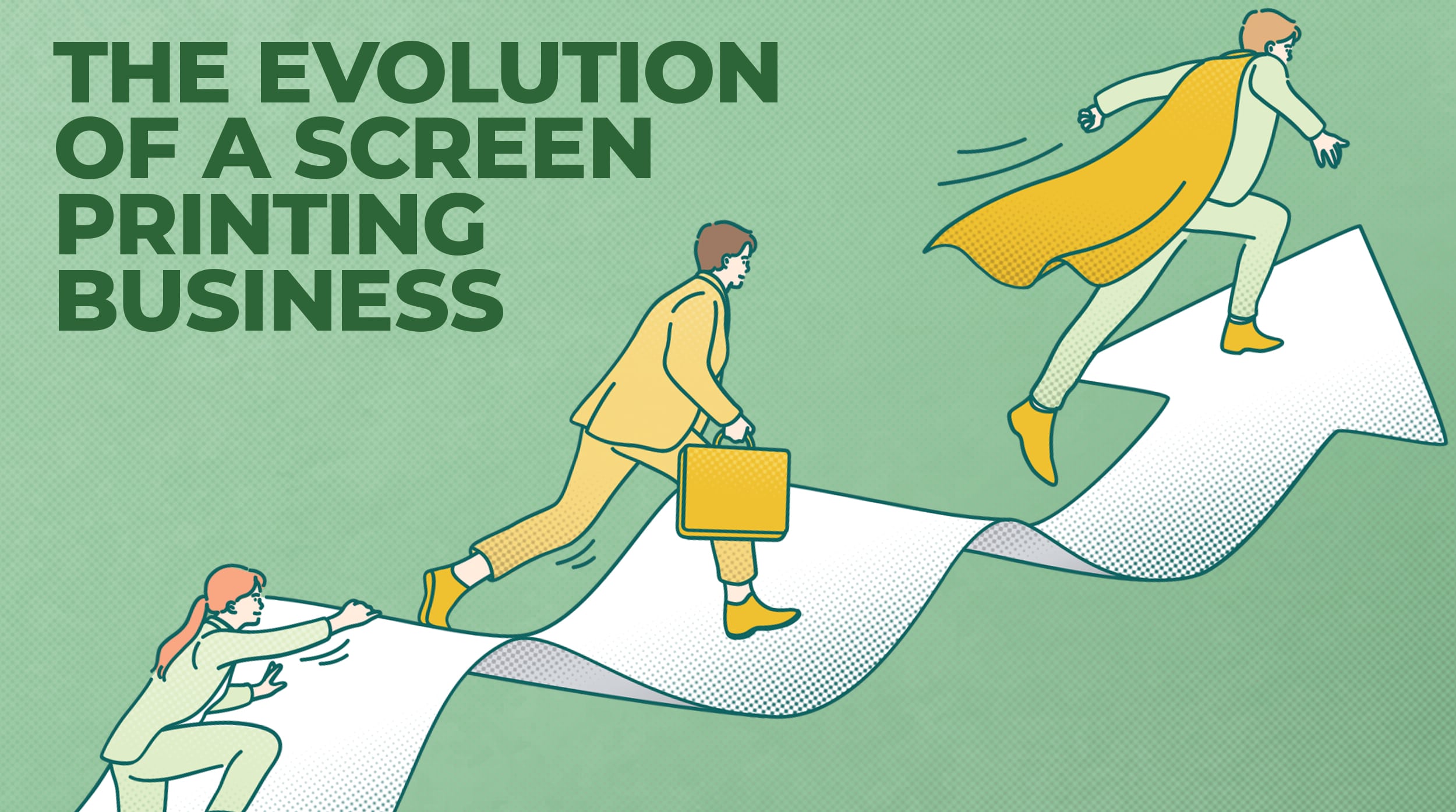LIKE FINGERPRINTS, no two screen printing businesses are the same. Nonetheless, companies generally evolve through the same general phases of growth. Whether their individual paths to success are short and straight or miles of twisted double-loops, screen printers are likely to encounter similar challenges along the way. The following provides an overview of each stage of growth as well as the most common struggles with moving on to the next.
Conception
Businesses begin with the germ of an idea. Some people want a way to monetize their creativity. Others see dollar signs in something and think, “Hey, how hard could that be?” Others back into the industry on the way to something else (that was my route). Regardless, putting time into market research and idea development at this phase can set a company apart from competitors. Writing a formal business and marketing plan is a great way for entrepreneurs to focus their time and energy.
Businesses at this phase should expect change. New opportunities, market changes, or “shiny object syndrome” can push a new company in a different direction. Growth in any direction will likely require new processes, systems, procedures, and tools. There may be pricing pressure or quality concerns. Overall, this can be a frustrating and anxiety-filled time. When they start out, most people don’t know what they don’t know.
However, savvier business owners understand basic industry concepts don’t exist in a vacuum. They prioritize finding a mentor, joining an industry community, attending a tradeshow, taking some classes, reading magazine articles like this one, listening to vendor supply reps, or otherwise obtaining the knowledge they need to improve.
They also understand that taking action on that knowledge is what makes a real difference. You can’t just read, watch, or listen. Put something into action, then improve it. And if your efforts don’t work out, that’s OK. The cycle of continuous improvement always has a “trying again” feature. The business term for this is “professional development.”
Growth
As headcount grows, a company operates differently. Generally, the more people you add, the more specialized their work becomes. Scaling growth also requires adding more than just people. Rock-solid processes, training programs, and SOPs will be necessary to ensure everyone performs their tasks similarly.
This is the phase when companies start measuring things. Metrics are taken, dashboards are built, and owners educate themselves, often to the point where they are no longer satisfied. They might aim to obtain new customers with innovation, expand into new markets, or get current customers to buy more frequently. Whatever “getting to the next level” means, at this point it is aspirational in nature. As sales ramp up and production begins to hit its limits, difficult decisions must be made.
Smarter leaders seek better tools to augment the weakest parts of the business. This could mean a better website or sales process. It could mean equipment purchases or production automation. This is also a good time to bring in an intellectual gunslinger – a CPA, consultant, coach, or even an industry colleague to help plot next steps. Often, the problems that surfaced originally in the first struggle round haven’t gone away; they simply moved.

Transition Period
This phase is marked by equipment purchases, infrastructure changes, and the building of websites, online stores, drip marketing campaigns, and lead-generation funnels to pay for everything. There is a concerted effort to redefine the company and brand positioning.
This is also where many of the original employees drop off. “You’ve gone corporate,” they say. The original company may be unrecognizable, but in a good way. The old guard is dropping off, but replacements are more aligned with the company’s trajectory.
This is where companies can get lost. A clear purpose, core values, and a sense of mission can be the guardrails needed to keep moving forward. Knowing your “why” – why you are in business and why a customer should do business with you – is crucial. Most successful businesses in the industry pursue only three or four types of clients. Perhaps it’s time to raise prices and minimum quantities to weed out customers that are no longer a good fit, and maybe even fire a few.
Put simply, the transition stage is when a company figures out what it wants to be when it grows up. Previous performance and sales hinted at the right direction. The transition period refines it. A company must adapt to what is working best, and refine its offerings based on thorough market research and a sincere business development effort.
Smarter leaders seek better tools to augment the weakest parts of the business.
Future
The screen printing industry is always changing. From new equipment, inks, and consumables to new fabrics and substrates, technology improves. Market concerns and governmental regulations also continue to evolve. And yet, a huge portion of our industry still behaves as it did 25 years ago. For younger companies that “don’t know any better,” this is an opportunity to gobble up customers that yearn for innovations and newer ideas.
Are you paying attention? How are you thinking about artificial intelligence, sustainability, or developments yet to come? Keeping your head down and working isn’t doing you any favors. You need to play in the sandbox with new tools to see what will fit your business.
The folks who always ask, “What if…?” and play around with ideas are the ones that are seemingly ahead of the curve most of the time. They keep pushing their own boundaries. They laugh at the status quo as they try to eliminate downtime or mitigate a challenge with some other pesky project. They constantly seek feedback from staff, vendors, and customers in efforts to improve different parts of the workflow.

Business Ending
Nobody wants to think much about how a business ends while the business is still operating. If they did, you would see some clearer thinking.
First, if you plan on selling the business, consider what someone will want to buy. Do you own your building, or are you renting? Are there contracts or agreements with customers? Do you have intellectual property, like a local T-shirt brand or anything else of value? These are just a few things a prospective business buyer will want to evaluate in determining how much your business is worth (see page 40 for more succession planning tips).
If you only have a handshake deal with customers, rent your space, and operate with equipment that was new back when Bill Clinton was president, you might not be able to get as much money as you think. As your business grows, focus on creating tangible assets, intellectual property, and strong customer relationships. All can help improve the value proposition for a potential buyer down the line.
Want more from The Marshall Plan? Read all of Marshall Atkinson’s columns at here.
Advertisement


 Case Studies2 months ago
Case Studies2 months ago
 Art, Ad, or Alchemy2 months ago
Art, Ad, or Alchemy2 months ago
 Andy MacDougall2 months ago
Andy MacDougall2 months ago
 Columns4 weeks ago
Columns4 weeks ago
 Editor's Note3 weeks ago
Editor's Note3 weeks ago
 Marshall Atkinson3 weeks ago
Marshall Atkinson3 weeks ago
 Thomas Trimingham2 months ago
Thomas Trimingham2 months ago
 Case Studies4 weeks ago
Case Studies4 weeks ago

















